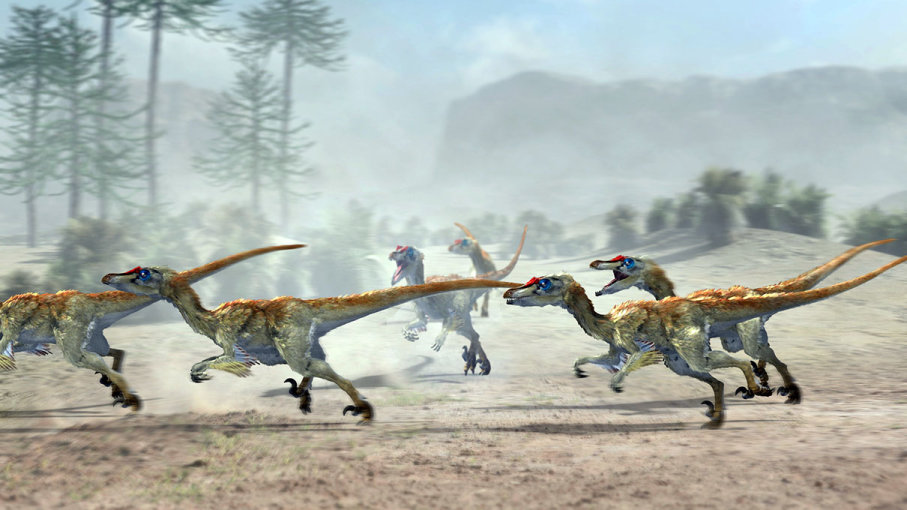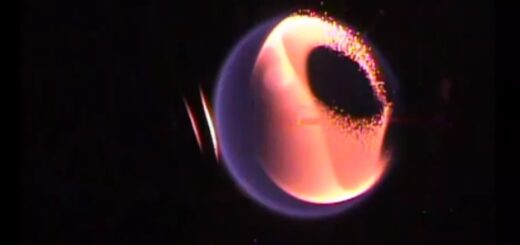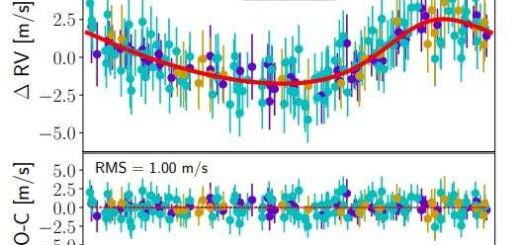Velociraptors Likely Hunted Solo, Despite Pop Culture Depiction

We’re now four films into the multibillion-dollar “Jurassic Park” film franchise, and the “raptors” are still fan favorites. Audiences revel in watching packs of them gang up on everything from khaki-clad riflemen to a hybridized dino monster. These attacks are organized, strategic and — in three of the movies, at least — they rely on a chain of command within the group.
Is such team-oriented behavior supported by the fossil record? Before we can answer that question though, we should clear something up.
Mistaken Identity
The dinosaur that’s called Velociraptor in the “Jurassic Park” movies and novels was based on a completely different animal known as Deinonychus. And when it comes to size, there’s a huge gap between the two. Velociraptor wasn’t much bigger than a turkey, but the adult Deinonychus measured 11 feet (3.3 meters) long and may have weighed more than 200 pounds (90.7 kilograms).
Both are classified as dromaeosaurids, a family of bird-like carnivorous dinos. Members of this group had a specialized toe on each foot, which — famously — was held in an upright position while they walked. In theory, that habit kept the large, hook-shaped claws on those digits nice and sharp. (Stay tuned for more details.)
Getting back to Deinonychus, this particular dinosaur was originally discovered in 1931 in Montana, but it wouldn’t be named until 1969. That’s when Yale paleontologist John Ostrom was overseeing a dig at a Montana quarry and the bones of four Deinonychus were found strewn around the partial skeleton of a much-larger herbivore called Tenontosaurus.
Late in his career, Ostrom compared this paleo crime scene to a wolf pack dispatching its prey. The four dead Deinonychus dinos, he theorized, had been killed while attacking the big plant-eater in a coordinated group effort. Later, other members of their pack presumably killed that tenacious Tenontosaurus.
A Wolf in Dinosaur’s Clothing
Ostrom’s work influenced author Michael Crichton, who wrote pack-hunting dromaeosaurs into the first “Jurassic Park” book. The concept has since taken hold of the public’s imagination. Moreover, it’s had a significant impact on dinosaur science. Theropods — the group containing birds and all known extinct, carnivorous dinos — are often found buried in close proximity to other members of their own species. Because of this, it’s been argued that plenty of non-dromaeosaur predators — like Tyrannosaurus and Allosaurus — might have hunted in packs, too.
But then again, perhaps they didn’t. In a 2007 paper, paleontologists Brian Roach and Daniel Brinkman dissected the issue at length. And in their opinion, neither Deinonychus nor Velociraptor nor any other non-avian predatory dinosaur would have formed packs. “Mammal-like cooperative pack hunting… [is] an extremely rare and complex behavior,” Daniel Brinkman says via email.
So let’s talk terminology. Brinkman and Roach’s paper defines “true cooperative pack hunting” as a group hunting effort carried out by animals that “habitually work together [with others of their species] to capture and subdue prey too large for an individual predator to kill alone.” Furthermore, these team-players also defend their territory collectively and may share youngster-rearing duties.
No living bird or reptile fits the criteria. It’s true that Nile crocodiles sometimes gang up on big mammals like wildebeests, but they later disperse. And although Harris hawks have been known to form hunting parties of up to nine birds, they target small game while doing so.
That said, there is one living animal that — according to Roach and Brinkman — might offer us some insight into how dromaeosaurs and other non-avian theropods behaved around big prey items: the Komodo dragon.
velociraptors hunting in pack
A pack of Velociraptors encircling a lone Protoceratops before they move in for the kill.
MARK STEVENSON/STOCKTREK IMAGES/GETTY IMAGES
Packs, Tracks and Mobs
Komodo dragons are solo hunters, and effective ones at that. An adult can bring down victims 10 times its own bodyweight. These reptiles are also eager scavengers, and when one of them kills a large prey item, others are likely to come running. What follows is a gruesome feeding frenzy, with a dozen or more Komodo dragons mobbing the carcass. Such meetings get violent fast. While squabbling over a corpse, Komodos may attack one another; sometimes, they even kill and eat their smaller competitors at the site.
So when paleontologists find a large collection of theropod bones and/or teeth in the same fossil deposit, what should they make of it? Should they interpret the remains like a wolf-style family unit? Or should they be viewed as the site of a disorganized mob, where side-squabbles and cannibalism would’ve been rampant?
For their part, Brinkman and Roach find the latter scenario more probable. “Deinonychus [and other non-avian theropods] were most likely solitary hunters who engaged in antagonistic, Komodo dragon-like feeding aggregations,” Brinkman says, “and … they interacted with each other in ways that were much more contentious, combative and cannibalistic than has widely been believed.”
Finding teeth and bones together is one thing, but what about dinosaur footprints? Can they shed any light onto the pack-hunting debate? In 2007, a 120-million-year-old dromaeosaur trackway was discovered in China. Six different sets of parallel tracks — each made by an animal standing about 4 feet (1.2 meters) tall at the hip — were found. And judging by the nature of the sediment, it looks like these prints were all laid down within a very short span of time.
Anthony J. Martin, a leading paleoichnologist (a “trace fossil scientist”) at Emory University, thinks the animals who made them were traveling in some kind of group. “The trackways show these dromaeosaurs were moving at about the same pace, in the same direction (parallel), and spaced more-or-less the same distance [apart]. So I’m fairly certain that this is evidence of group behavior,” he says via email.
Still, this doesn’t necessarily mean the dromaeosaurs hunted in packs. Maybe they were rushing toward a dead body like those independently minded Komodo dragons. In order to confidently cite any footprint assemblage as the product of pack-hunting or a similar activity, we’d need “more evidence, such as tracks of a prey animal that was clearly preceding them, and not by much time,” says Martin. “Best of all would be the dromaeosaur tracks ending at a kill site. An ichnologist can dream, right?”



 Creators of mankind
Creators of mankind Description of “Tall white aliens”
Description of “Tall white aliens” Where they came from?
Where they came from? About hostile civilizations
About hostile civilizations The war for the Earth
The war for the Earth “Tall white aliens” about eternal life
“Tall white aliens” about eternal life Video: “Nordic aliens”
Video: “Nordic aliens” Aliens
Aliens Alien encounters
Alien encounters The aliens base
The aliens base UFO
UFO Technology UFO
Technology UFO Underground civilization
Underground civilization Ancient alien artifacts
Ancient alien artifacts Military and UFO
Military and UFO Mysteries and hypotheses
Mysteries and hypotheses Scientific facts
Scientific facts


















